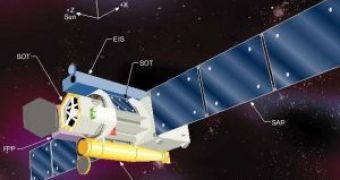Imagine an explosion equivalent to about a billion nuclear bombs dropped simultaneously releasing the energy in the form of radiation, high energy particles and magnetic fields. Such is a solar flare. The Sun is made of plasma - an ionized gas of mostly hydrogen and helium. Because it is made of huge masses of electrically charged particles, the Sun experiences powerful magnetic fields. Scientists think the flares are formed when lines of the magnetic fields clash together. The field lines drag the hot gas with them and when they overlap, huge explosions occur and the plasma is ejected throughout the solar system. (Read more.)
The protons are accelerated at such speeds that they reach Earth within tens of minutes (sunlight reaches Earth in around 8 minutes). A few days later, there are the Coronal Mass Ejections: huge bubbles of gas wrapped around magnetic field lines, which can cause major magnetic disturbances on Earth.
"Solar flares are fast and furious - they can cause communication black-outs at Earth within 30 minutes of a flare erupting on the Sun's surface. It's imperative that we understand what triggers these events with the ultimate aim of being able to predict them with greater accuracy" said Prof. Louise Harra from the University College London's Mullard Space Science Laboratory (UCL/MSSL).
For this purpose, the scientists are preparing a spacecraft, called Solar-B, which will orbit the Earth on a Sun-synchronous orbit - an orbit that passes over any given point of the Earth's surface at the same local solar time.
"The Sun behaves unpredictably and will be as likely to flare during spacecraft 'night' when Solar-B would be behind the Earth, which is why we have chosen a special type of polar orbit that will give us continuous coverage of the Sun for more than 9 months of the year," said Prof. Len Culhane from UCL/MSSL, Principal Investigator of the Extreme Ultraviolet Imaging Spectrometer (EIS) instrument on Solar-B.
Solar-B will measure the movement of magnetic fields and how the Sun's atmosphere responds to these movements. Since the Sun's surface is changing very rapidly, Solar-B will be able to distinguish between steady movements and the changes that build-up to a flare. Hopefully, the satellite would reveal the so-called 'trigger phase' of the flares.
The instruments of Solar-B include a 0.5m optical telescope (SOT), an Extreme Ultraviolet imaging spectrometer (EIS) and an X-ray/Extreme Ultraviolet telescope (XRT). The instruments will work together as an observatory. The Solar Optical Telescope (SOT) will also include the Focal Plane Package (FPP) which will survey the magnetic fields, will use the Doppler shift to measure the velocity of particles and will measure the intensity of solar activity. The telescope will measure the dynamical behavior of the Sun's atmosphere to a higher accuracy than ever before.
"Solar-B will give us an increased understanding of the mechanisms which give rise to solar magnetic variability and how this variability modulates the total solar output and creates the driving force behind space weather," said Prof. Keith Mason, CEO of the Particle Physics and Astronomy Research Council (PPARC), the funding agency behind UK involvement in the spacecraft. Prof. Mason added, "Predicting the timing and strength of solar flares is critical if we want to mitigate the threat to orbiting spacecraft and Earth-based communication systems".
The spacecraft will be launched on the 22nd September from the Japan Aerospace Exploration Agency (JAXA) Uchinoura Space Centre at Uchinoura Kagoshima in southern Japan.

 14 DAY TRIAL //
14 DAY TRIAL //